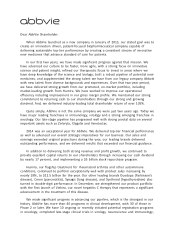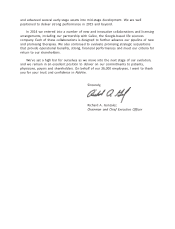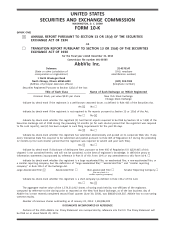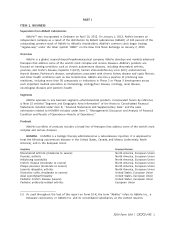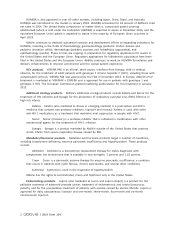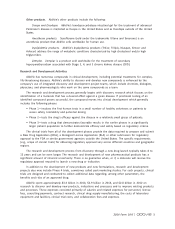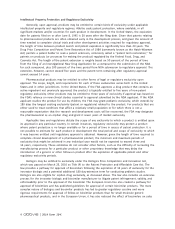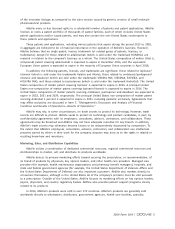AbbVie 2014 Annual Report Download - page 10
Download and view the complete annual report
Please find page 10 of the 2014 AbbVie annual report below. You can navigate through the pages in the report by either clicking on the pages listed below, or by using the keyword search tool below to find specific information within the annual report.
13NOV201221352027
Intellectual Property Protection and Regulatory Exclusivity
Generally, upon approval, products may be entitled to certain kinds of exclusivity under applicable
intellectual property and regulatory regimes. AbbVie seeks patent protection, where available, in all
significant markets and/or countries for each product in development. In the United States, the expiration
date for patents filed on or after June 8, 1995 is 20 years after the filing date. Given that patents relating
to pharmaceutical products are often obtained early in the development process, and given the amount of
time needed to complete clinical trials and other development activities required for regulatory approval,
the length of time between product launch and patent expiration is significantly less than 20 years. The
Drug Price Competition and Patent Term Restoration Act of 1984 (commonly known as the Hatch-Waxman
Act) permits a patent holder to seek a patent extension, commonly called a ‘‘patent term restoration,’’ for
patents on products (or processes for making the product) regulated by the Federal Food, Drug, and
Cosmetic Act. The length of the patent extension is roughly based on 50 percent of the period of time
from the filing of an Investigational New Drug Application for a compound to the submission of the NDA
for such compound, plus 100 percent of the time period from NDA submission to regulatory approval. The
extension, however, cannot exceed five years and the patent term remaining after regulatory approval
cannot exceed 14 years.
Pharmaceutical products may be entitled to other forms of legal or regulatory exclusivity upon
approval. The scope, length, and requirements for each of these exclusivities varies both in the United
States and in other jurisdictions. In the United States, if the FDA approves a drug product that contains an
active ingredient not previously approved, the product is typically entitled to five years of non-patent
regulatory exclusivity. Other products may be entitled to three years of exclusivity if approval was based on
the FDA’s reliance on new clinical studies essential to approval submitted by the NDA applicant. If the NDA
applicant studies the product for use by children, the FDA may grant pediatric exclusivity, which extends by
180 days the longest existing exclusivity (patent or regulatory) related to the product. For products that are
either used to treat conditions that afflict a relatively small population or for which there is not a
reasonable expectation that the research and development costs will be recovered, the FDA may designate
the pharmaceutical as an orphan drug and grant it seven years of market exclusivity.
Applicable laws and regulations dictate the scope of any exclusivity to which a product is entitled upon
its approval in any particular country. In certain instances, regulatory exclusivity may protect a product
where patent protection is no longer available or for a period of time in excess of patent protection. It is
not possible to estimate for each product in development the total period and scope of exclusivity to which
it may become entitled until regulatory approval is obtained. However, given the length of time required to
complete clinical development of a pharmaceutical product, the minimum and maximum periods of
exclusivity that might be achieved in any individual case would not be expected to exceed three and
14 years, respectively. These estimates do not consider other factors, such as the difficulty of recreating the
manufacturing process for a particular product or other proprietary knowledge that may delay the
introduction of a generic or other follow-on product after the expiration of applicable patent and other
regulatory exclusivity periods.
Biologics may be entitled to exclusivity under the Biologics Price Competition and Innovation Act,
which was passed on March 23, 2010 as Title VII to the Patient Protection and Affordable Care Act. The
law provides a pathway for approval of biosimilars following the expiration of 12 years of exclusivity for the
innovator biologic and a potential additional 180 day-extension term for conducting pediatric studies.
Biologics are also eligible for orphan drug exclusivity, as discussed above. The law also includes an extensive
process for the innovator biologic and biosimilar manufacturer to litigate patent infringement, validity, and
enforceability prior to the approval of the biosimilar. The European Union has also created a pathway for
approval of biosimilars and has published guidelines for approval of certain biosimilar products. The more
complex nature of biologics and biosimilar products has led to greater regulatory scrutiny and more
rigorous requirements for approval of follow-on biosimilar products than for small molecule generic
pharmaceutical products, and in the European Union, it has also reduced the effect of biosimilars on sales
42014 Form 10-K



